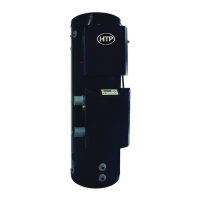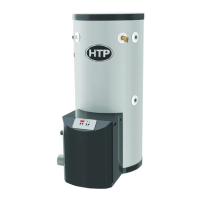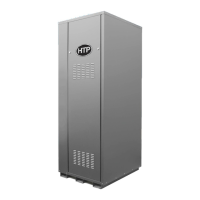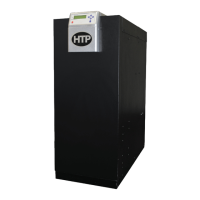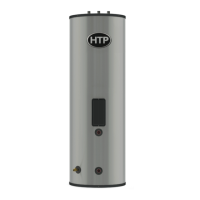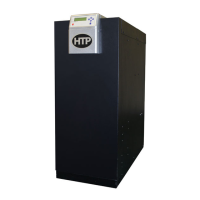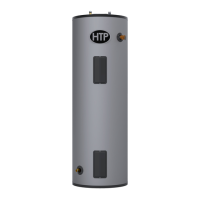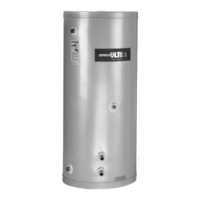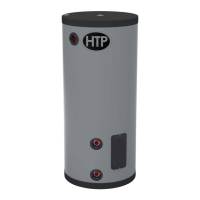LP-179 Rev. 6.7.16
14
Part 4 - Piping
Failure to follow the instructions in this section WILL VOID the
warranty and may result in property damage, severe personal
injury, or death.
Dielectric unions or galvanized steel ttings must not be used
in a system with this water heater. Doing so WILL VOID the
warranty. Use only copper, brass, or stainless steel ttings.
Teon thread sealant must be used on all connections.
DO NOT pipe this water heater with black iron, galvanized
steel, steel, or lead pipe. Doing so will result in premature
product failure and property damage, and WILL VOID the
warranty.
A. Heater Plumbing
Use two wrenches when tightening water piping at heater.
Use one wrench to prevent the heater return or supply line
from turning. Failure to prevent piping connections from
turning could cause damage to heater components.
The heater control module uses temperature sensors
to provide both high limit protection and modulating
temperature control. The control module also provides low
water protection by sensing the water level in the tank. Some
codes / jurisdictions may require additional external controls.
The domestic water connections must be installed in
accordance to all local and national plumbing codes, or any
applicable standard which prevails. The inlet (cold) and outlet
(hot) ports are 1” on 55 gallon models, and 1 1/2” on 80 and 119
gallon models.
On the cold inlet, install a 1” brass tee on 55 gallon models, or
a 1 1/2” tee on 80 and 119 gallon models. On the run of the 1”
brass tee, install a 1” brass drain cock or equivalent with pipe
sealant compound. In the branch of the 1” or 1 1/2” brass tee,
install a copper male adapter to match your copper plumbing
system. For convenience, it is recommended to install a sweat
shut-o valve and a union in the cold inlet piping and hot outlet
to ease future servicing. If there is a backow preventer or any
type of a no return valve in the system, install an additional
tee here, suitable for a potable hot water expansion tank.
In the hot outlet, install a suitable adapter to match the
copper tubing of the plumbing system. A thermal trap or heat
trap loop may be installed here to provide additional energy
savings and prevent the thermal siphoning of domestic hot
water.
B. Auxiliary Connections
The auxiliary connections are additional connections for a
recirculation connection, air handlers, plate exchangers, or
other devices that supply hot water. These connections must
be installed in accordance with all local and national codes or
any applicable standard that prevails. Auxiliary connections
are 1” on all models. Never use dielectric unions or galvanized
steel ttings. Use only copper or brass ttings. Sealant must
be used on all connections. The top port is the outlet and the
bottom port is the inlet.
Never connect auxiliary connections to any system that uses
glycol or other solutions formulated for hydronic systems.
These auxiliary connections are to be used only in a potable
water system. Failure to follow this warning could result in
serious injury or death.
C. Backow Preventer
Use a backow preventer specically designed for water heater
installations. This valve should be installed on the cold water ll
supply line per local codes.
D. Potable Expansion Tank
A potable hot water expansion tank is required to oset heated
water expansion. In most city plumbing systems, the water
meter has a no return or back ow device built into the system to
prevent back owing of water into city mains. Some local codes
require back ow preventers on all incoming water supplies. The
hot water expansion tank must be listed for potable water use.
The expansion tank should be located on the cold inlet piping
close to the water heater.
Expansion Tank and Make-Up Water
1. Ensure that the expansion tank is sized to correctly handle
heater and system water volume and temperature.
Undersized expansion tanks cause system water to be lost from
the relief valve, causing make-up water to be added. Eventual
heater failure can result due to excessive make-up water
addition. SUCH FAILURE IS NOT COVERED BY WARRANTY.
The expansion tank must be suitable for hot potable water
systems.
2. The expansion tank must be located as shown in Applications,
this manual, or following recognized design methods. See
expansion tank manufacturer’s instructions for details.
E. Temperature and Pressure Relief Valve
To avoid water damage or scalding due to relief valve operation:
• Discharge line must be connected to relief valve outlet
and run to a safe place of disposal. Terminate the
discharge line in a manner that will prevent possibility of
severe burns or property damage should the relief valve
discharge.
• Discharge line must be as short as possible and the same
size as the valve discharge connection throughout its
entire length.
• Discharge line must pitch downward from the valve
and terminate at least 6” above the oor drain, making
discharge clearly visible.
• The discharge line shall terminate plain, not threaded,
with a material serviceable for temperatures of 375
o
F or
greater.
• Do not pipe discharge to any location where freezing
Overheated water and high pressures can cause water tank
explosion. A properly sized temperature and pressure relief
valve must be installed in the opening provided on the water
heater. Failure to install a properly sized temperature and
pressure relief valve could result in explosion and property
damage, serious injury, or death.
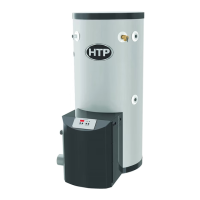
